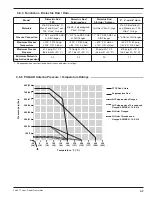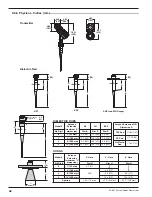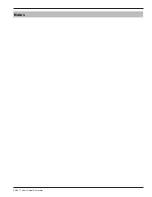
44
58-601 Pulsar
®
Radar Transmitter
Range
The distance over which the transmitter scans for valid
return signals.
RateChng
Rate of Change
The maximum velocity of vertical
movement of a liquid’s surface.
Relative Dielectric
(
ε
r
) A unitless number that indicates the
relative permittivity of a material.
Repeatability
The maximum error between two or more output
readings of the same process condition.
RFI
Radio Frequency Interference
Electrical noise that can have
an adverse affect on electrical circuits, particularly low-power
devices.
Safety Zone
A user-defined area just below the Blocking
Distance where level measurement still has a high degree of relia-
bility. Radar can develop ambiguous readings when the level
reaches the region of the antenna. An alarm can be annunciated
in this area for critical applications where reliable measurement is
a necessity for safety reasons.
Safety Zone Height
The height of the region below the
Blocking Distance where an alarm will be annunciated upon
detection of liquid.
Safety Zone Fault
An optional condition added, when necessary,
to ensure safe, reliable high-level readings in critical applications.
Choices are 3.6 mA, 22 mA, Latch 3.6 or Latch 22. If Latch 3.6
or Latch 22 are chosen, the loop current will remain in alarm
until it is cleared in SZ Latch menu screen.
Safety Zone Alarm Reset
Use screen for clearing a Latched
Alarm set in
Safety Zone Fault
(above)
SnsrOfst
Sensor Offset
The distance (+ or -) between the
customer’s 100% reference point (tank top) and the Sensor
reference point (bottom of NPT thread, top of BSP thread
or face of flange).
Span
The difference between the upper and lower limits of the
range.
Specific Gravity (SG)
The ratio of the density of a material to
the density of water at the same conditions.
Sensitivity
The amount of amplification applied to the Level
signal; a higher value aids in measuring low dielectric media; a
lower number assists in ignoring nearby objects.
Status
The current state of the transmitter’s diagnostics; screen
updates every 10 seconds.
Targets
Objects in the vessel that create reflections of the radar
signal (microwave energy).
Targ Rej
Target Rejection
The ability to ignore reflections from
objects in the vessel that are not the liquid level, i.e., false targets
(e.g. pipes, ladders, baffles).
Tank Ht
Tank Height
The tank measurement between the 0%
(tank bottom) and 100% (tank top).
Tank Top
The 100% point in a vessel. Also considered for the
type of tank top; e.g. flat, dome, etc., which affects the develop-
ment of multiple echoes during high level conditions. Multiple
echoes can appear as an invalid Level signal.
TDR (Time Domain Reflectometry)
Uses a waveguide to carry
EM energy to and from the surface of the media to measure dis-
tance; similar to conventional through-air Radar but much more
efficient. Also called Guided Wave Radar.
Trim 4/Trim 20
Built-in system capability to fine tune the
4 mA and 20 mA points so the transmitter output corresponds
exactly to user’s meter, DCS input, etc.
Trim Lvl
Trim Level
An offset parameter used to account for
various deviations in measurement. It is an offset value that can
force the transmitter to read the exact level reading.
Turbulnc
Turbulence
Agitation, or disturbance, of the liquid
level surface; greater the agitation, greater the scattering of the
radar signal (microwave energy).
Two Wire
An electrical instrument design that uses one set of
wires to provide both the supply power and process measure-
ment signal. The process measurement is achieved by varying the
current of the loop. Also called Loop Powered.
Units
The engineering units used to measure level in the
system. The choices are in (inches) and cm (centimeters).
Warning (message)
The second level in the hierarchy of
Diagnostics annunciating conditions that are not fatal but may
affect measurement. A message will occur on the main (rotating)
screen when a Warning is detected but will not affect output
current. Further information can be obtained by viewing the
Status or Diagnostic screens.





































